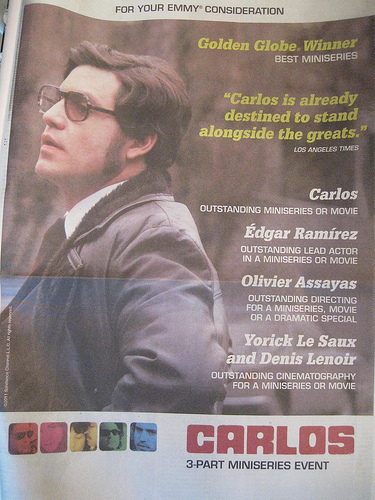Jeff VanderMeer's Blog, page 57
June 18, 2011
LA Times Feature on Steampunk Bible and League of STEAM
(The video shot at the Edison with the League, while being interviewed for the LA Times)
The LA Times features our book, the League of Steam, Clockwork Couture, and more. I led the reporter around LA talking to Steampunks and whatnot for a day last month, and had a lot of fun. I have to say–The Edison is absolutely magnificent, and I would say that a "steampunk" vibe is really just a small part of why it is so incredibly cool. The space and the way it's been refurbished is remarkable. Anyone visiting LA should go take a look.
The Sydney Morning Herald also did a piece on Steampunk, including quotes from my coauthor SJ Chambers and me.
LA Times Feature on Steampunk Bible and League of STEAM originally appeared on Ecstatic Days on June 18, 2011.




June 16, 2011
The Journals of Doctor Mormeck: Entry #6
Note: Like this serialized long story/novella? Paypal me what you think it's worth to vanderworld at hotmail.com. Donations above $21 will entitle you to a free copy of whatever anthology it eventually appears in, or any initial stand-alone book version.
Archive: Journals of Mormeck
The first six of the twelve recovered in canisters from the war-torn winter city came back to us sane but with their memories wiped clean and their motor functional infantile. The seventh was insane at first. They resurrected him from his own ashes and he screamed with the first breath of air in his lungs. He was one of the angels, but still he screamed, as if he didn't remember. His name was given to me as "Kathar," and he had been tortured in the winter city.
After a time, Kathar stopped screaming and regained the preternatural confidence that marks all of these "angels." Kathar had been on surveillance elsewhere but something he had seen that now existed as a hole in his memory had sidetracked him. Before he had been taken, Kathar had destroyed his own wings, changed his eyes, created for himself a uniform of white-and-gray that matched the besiegers, who he thought were winning the war. Then the other side had found him, and brought him to a hospital that wasn't for sick people but for experiments. There, he was interrogated and tortured, and when he didn't talk they burned him alive, some inkling having formed in his captors' minds, Kathar said, that he was not entirely human.
This was all I knew because this was all I observed before the others took him someplace more private for a full debriefing. Some time afterwards, the leader of our laboratory, who calls himself Gabriel "but only as a joke" came to confer with my laboratorial avatar. Gabriel has my respect, but I think he likes his naming joke too much; a joke can grow into a truth, and a truth become someone's burden.
Gabriel came to recruit me in a new way, one that went beyond our agreement. "Kathar tells a story that disturbs us greatly." As his mouth curled upward in an almost-smile that his kind could not help. "He says he came into contact with a presence, and that this presence influenced his captors—first in the capture itself and then what happened afterwards. Kathar believes that under cover of the torture, this presence took something from him."
I knew that the angels had their enemies, that part of their purpose in establishing the laboratory was not simply to monitor for irregularities, for things that might naturally create instability, but also to combat interference from others. They had never named these "others" to me, and it had not mattered to me. For me, if I must be honest, just the opportunity to glimpse through surveillance a hundred different worlds was enough.
But when I questioned Gabriel on this point, he shook his head, and even the half-smiled seemed oddly tinged with doubt…even fear. "This is nothing we have encountered before. No one has watched us, the watchers, before without our knowledge. Those who know of us, know because we wish it."
Then he told me they needed my help, that someone needed to return to that winter war, in that particular reality, and investigate, report back. It could not be the remote surveillance of the luna moths. It could not be another angel, because this presence could track them "as if we have a recognizable heat signature" that registers on their instruments. Gabriel said they needed me to go. They needed my budded avatar to go because Mormeck Mountain could change not just Mormeck Outpost's appearance but also the cellular composition. "You will go, with our instructions," Gabriel said, "and as soon as you are there, you will alter yourself to perfectly mimic the humans there. The presence may sense your arrival, but then you will go dead to them."
Was this, perhaps, what Gabriel and his kind had been moving toward all along? That I become not just monitor, home, and house to their efforts, but also active spy? Part of me wanted to scream as Kathar had screamed, at the thought of the unknown, but the greater part felt a great upwelling of an emotion close to happiness. My avatar was me, yes, but also separate from me. Once embedded in the winter city, my avatar's bond with Mormeck Mountain would be broken, and we would have to synchronize our memories once I returned to myself, but I was as much me as Mountain as avatar, and vice versa. It was not even that my avatar would be a copy of me—we both were emissaries of a greater whole, a city, a host, that happened to appear as one creature. If Mormeck Mountain were to come to grief while Mormeck Mobile roamed a far-off place, then it would be Mobile that became Mountain, over time, lacking only a week or a few months of memory.
In a word, I said yes to Gabriel, and they prepared me for the journey today. I received four objects to take with me, all made very small. They briefed me on the specifics of the local conflict in a place "most commonly known across the alt-Earths as Stalingrad" and noted that in this particular iteration of that conflict "The forces of Adolf Hitler, a genocidal despot, have laid siege to the defenders, soldiers for the Soviet Union, an empire run by a autocrat named Trotsky." He hesitated then, as much as Gabriel ever hesitates. "Complicating matters slightly, a third force works in Stalingrad: a highly evolved carnivore not native to Earth, with supreme powers of camouflage and working without the knowledge of the human population. We call them Komodos after an Earth species, but that's not really what they are; and they are neither our enemies nor our friends. You can trust no one. Trade allegiances, even shape, as necessary."
"Where do I start?" I asked.
"In the hospital where we found the ashes," Gabriel said. "Any orthodoxy, any ideology, whether progressive or repressive, is a weakness, Mormeck. Anyone free of it can manipulate it, while anyone who is a true believer cannot be free of it, and will react in one of a limited number of ways. Use their ideology against them." He had uploaded into my avatar a complete knowledge of all factions, including the Komodos—their history, their beliefs, and the wider context. I was also equipped with new languages that felt itchy in my avatar's mind. I decided, too, to bring my "journal" with me, hidden within a sealed pouch of skin against my thigh. I could write in it without taking it out of my body.
"And what of the presence?"
"You will encounter proxies of the presence, and you will know them because in their speech and their actions they almost but not quite match the orthodoxies of which we have spoken. You will record all information about the presence that you can, and you will not engage the presence unless forced to."
"And if I am in danger?" After the seventh reconstituted from ash, the last five had been placed in a secure facility. All five had suffered psychotic breaks as soon as they'd regained consciousness.
"We will give you the coordinates for doors back."
Then it was just a matter of traveling to Stalingrad. Except the journey wasn't as easy for me as for the angels. They carried that power in their bodies, the knowledge of it, the ability for it. They were doors, in a sense. But only they could open those doors and go through. For me, as for anyone else, the process was perilous and painful. My avatar would have to walk across the lawn outside of the laboratory, into the little forest, and there be devoured alive by the sentinel bear known as Seether. He would strip my flesh down to the bone with claw and fang, and feast on my remains…and when I was nothing but bones, he would crack the marrows and eat all of me…and then and only then would I travel across the alt-worlds to my destination, knit back together. I would not scream because I would suppress my nerve endings first, but it would not be a pleasant sensation. Seether too was a door—ancient and feral and containing worlds. He too was, in his way, as aesthetically pleasing as the luna moths or any other of the angels' discoveries, experiments, and inventions. But not to the traveler. To the traveler, he was the very experience of violent death, even though was no other way.
Of course, the angels came to watch. To them, it was funny, and their half-smiles became broad and merry even as my view of them dissolved in a sudden spray of my own blood and tissue.
Avaunt!
The Journals of Doctor Mormeck: Entry #6 originally appeared on Ecstatic Days on June 16, 2011.




June 15, 2011
The Return of the Ugly Brother…and Some Curmudgeonry
Lovecraft's ugly brother (well, they're both ugly) has returned from a three-year stint serving time in the SF Museum. He's been oogled and admired by thousands. Reunited, neither of one of them is saying anything, but they will soon feature in a webcomic I'm putting together. They'll talk then, dammit!
In other news, USA Today's Pop Candy lurves the Steampunk Bible. But I'm here to talk about more serious matters. Like…
—Don't email me to ask "What is Steampunk?" I am not the king's hand for steampunk. I am not the instant Obvious Information Dispenser. Google it.
—Don't email me to ask about squid anymore. I mean, seriously. Don't email me to say, "Hey, I saw this squid while I was snorkeling, and it about yay-big and these colors. Do you know what it was?" It was a squid. Now go google it.
—Don't email me with photos of mushrooms you found and ask me to identify them, either.
In general, I am not your personal Google. Thanks, though, for continued comments about my books. Those help keep me going, in all my glorious curmudgeonry. But otherwise…I'm just not going to be answering anything stupid anymore. All indications to the contrary, I think I've been too approachable in the past.
The Return of the Ugly Brother…and Some Curmudgeonry originally appeared on Ecstatic Days on June 15, 2011.
June 14, 2011
The Alchemists of Kush by Minister Faust Debuts Tomorrow!!!
If you go on facebook, you can join Minister Faust's online release part for his awesome new novel The Alchemists of Kush tomorrow. Make sure to buy the book tomorrow, which is just a $2.99 e-book download. That's a total steal. More on this book Thursday (I'm off the grid tomorrow). Signal boost as you will, weirdies. I'd appreciate it.

The Alchemists of Kush by Minister Faust Debuts Tomorrow!!! originally appeared on Ecstatic Days on June 14, 2011.
SQUIDANTHROPY: New Tales From Ambergris
…Okay, so "Squidanthropy" might not be the final title, but I am happy to say that Centipede Press and my agent are wrapping up the details on a new collection of Ambergris stories, to be illustrated by the amazing Richard A. Kirk…
…except, it's a little more complicated than that, as these things sometimes are….
Richard read City of Saints & Madmen recently and sent me a facebook message to say how much he liked it. I noticed he was an artist, and so I checked out his work. You don't necessarily like someone's stuff just because they liked yours, but in this case I was blown away. I have to admit I'd never seen his art before, and it's wonderful.
So since Richard had said he'd like to do a project someday, I pinged him and asked if he'd consider doing art inspired by his reading of City of Saints. I would then write Ambergris fiction inspired by his art. I suggested this because I'm genuinely curious as to what Richard comes up with, but also because I don't currently have a way in to writing more Ambergris short fiction. I know from past experience that all I really need is the right kind of trigger, however.
Also, I want to get back to writing more short fiction, and short fiction that's in my personal sweet spot. I can and do write personal fiction in a variety of modes, but lately I've been hankering for a return to the kinds of things explored through my Ambergris stories. What will probably result, too, will be tales set throughout the period of time covered by City of Saints.
Although the project is being pre-sold, there're no pre-conditions on the stories, which is very attractive to me. Richard will create about 10 originals and a title page/cover (I believe). As he finishes an illustration, I will then write a story around it, so I can easily slot these stories around existing commitments. Some will no doubt be short, others may linger awhile. I'm going to go wherever his art takes me. The finished book will be between 35,000 and 60,000 words, depending. And since it's Centipede, you know it will be absolutely beautiful. I'm very excited.
When I have pre-order information, I'll let you know.
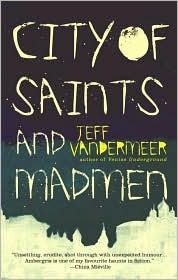
SQUIDANTHROPY: New Tales From Ambergris originally appeared on Ecstatic Days on June 14, 2011.
June 13, 2011
Evil Monkey Revisits George R.R. Martin's A Feast for Crows
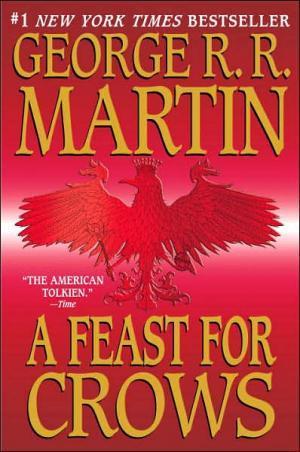
Jeff:
You've re-read A Feast for Crows (A Song of Ice and Fire, Book 4) by George R.R. Martin, too, haven't you?
by George R.R. Martin, too, haven't you?
Evil Monkey:
Yes. No way am I scaling the mountain that is A Dance with Dragons: A Song of Ice and Fire: Book Five without reminding my brain of prior context.
without reminding my brain of prior context.
Jeff:
What did ya think?
Evil Monkey:
What did you think?
Jeff:
On count of three, we both shout out what we thought…One…Two…Three!
Jeff/Evil Monkey (simultaneously):
CORPSEY CORPSEY STABBY BLEAK STABBY CORPSEY GROSS HORRIFYING CORPSEY CORPSEY
Jeff:
Hmmm. What're the odds of that?
Evil Monkey:
Let's face it, it was both full of stabbyness and corpses.
Jeff:
What about the source of those hangings?
Evil Monkey:
Oh. My Gawd!
Jeff:
I know, right!
Evil Monkey:
And that fight by the sea, on the cliff!
Jeff:
Oh. My God. And what happens to the queen?!
Evil Monkey:
Oh my god! I know! And those ironborn extra-drowned guys!
Jeff:
And Stark's stabby daughter!
Evil Monkey:
You can see she's gonna bring a world of hurt down on somebody soon.
Jeff:
I know, right?! Wow.
Evil Monkey:
So…did you like it?
Jeff:
Did you like it?
Evil Monkey:
I soooo liked it.
Jeff:
Me, too. I thought it was great.
Evil Monkey:
And the first time I read it I thought it was a big stinking pile of monkey feces.
Jeff:
Me, too. It smelled just like you.
Evil Monkey:
No, it smelled like you.
Jeff:
Well, it smelled.
Evil Monkey:
What changed?
Jeff:
I dunno about you, but I read those first three books in like two weeks. I lost so much sleep reading those books it was like I was on crack. I couldn't stop reading them, and then I'd stop reading them because I didn't want them to end. But I got to them late, so Feast came out about six months after I finished the first three…and I wanted Tyrion and the dragon queen and all of those characters…and they weren't in there.
Evil Monkey:
And now you didn't want them?
Jeff:
Honestly, I had to consult Wikipedia to remember everything that had happened, so encountering Feast unmoored from my expectation of needing Tyrion in there, I thought it was pretty darn awesome. I now disagree with the haters. the writing is first-rate and the anti-quests along with the state of things for the queen and her son…nicely done. And those ironborn are bad-asses.
Evil Monkey:
They sure are. I'm hoping that daughter-heir kicks all their butts, though.
Jeff:
Me, too.
Evil Monkey:
I just about ran out of the room screaming when [redacted] returned. OMG.
Jeff:
I know! I don't know if people realize how much this series depends on horror, and a working knowledge of horror tropes.
Evil Monkey:
Yeah, grim grim grim.
Jeff:
Yup. Grim crack you can't stop scarfing down. This is like caviar for pessimists.
Evil Monkey:
Aye, it is. Coulda done without the Sam parts, though.
Jeff:
Always gotta end on a downer, don't you, dipweed?
Evil Monkey Revisits George R.R. Martin's A Feast for Crows originally appeared on Ecstatic Days on June 13, 2011.




June 12, 2011
Fire and Ice: I Doth Not Apologize for My Cheatery
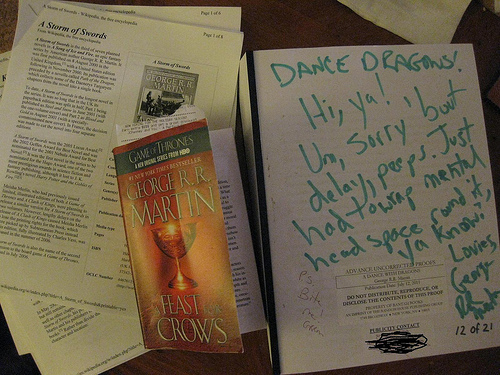
(The messages on the cover of the GRRM advance reading copy are NOT from the author, but a hoax I played on my facebook friends. I repeat: A forgery.)
For the record, I am not going to apologize for pulling out all the stops in my prep for reviewing the new George R.R. Martin novel A Dance with Dragons. That means I have been rapaciously feeding off of all applicable Wikipedia entries, revisiting the fifth book, watching the HBO series based on the first novel, and in all possible ways trying to once again get a handle on this vast, sprawling cast of characters and situations. What? Sansa's name changes? Wait. What? That dead character is actually kinda alive? Ewww. Oh, Iron Isles, why doth you have so many possible pretenders to the throne?
I defended the house from an assailant the other day with the Dance with Dragons advance reading copy. The assailant, with a long gray beard and carrying a leather-bound leviathan of a Bible, came running up the driveway with book held high, like some kind of bibliophilic hedge knight, and I met him with my Dance of Dragons, and we struggled mightily to an impasse, whereupon he gave up with a curse and we went and got some lemonade while I complained about how freakin' huge and long this new novel is…
But. I do not apologize for my cheatery.
Fire and Ice: I Doth Not Apologize for My Cheatery originally appeared on Ecstatic Days on June 12, 2011.




Movie Review: Carlos, Based on the Life of The Jackal
Carlos the Jackal was most famously associated with killings, kidnappings, and hijackings attributed to Palestinian terrorist organizations, but as with many purported idealists—including cold-blooded murderers like Carlos—as the authorities closed in on him and his networks, he became more of a terrorist-for-hire. The ideology became contaminated by his own ego, his need for money and security, his contempt for women associated with various the causes, and his own irrelevance in later years. In those later years, he lost discipline, focus, and became a pawn used by various countries, like Syria, to improve relationships with the West.
At least, this is the view taken by the mini-series/movie Carlos, which uses an often pseudo-documentary style to tell this fictional story, based on the known facts, of the infamous terrorist's exploits. The movie doesn't balk at showing the human cost on innocent civilians of Carlos' actions. Nor is it afraid to be wide in scope, making the excellent decision to introduce new characters with a short titled description on the screen, with name and role in either the hierarchy of terrorism/revolution or of law enforcement. The conciseness of decisions like these allows the filmmakers to focus in detail on Carlos' rise, the intricacies of his most infamous operations, and to explore his relationships with other terrorists and revolutionaries.
The movie shares affinities with the excellent Baader Meinhoff Complex, covering part of the same period and some of the same personalities, given that Carlos' operations often relied on the involvement of German extremist on the left—mostly the ones committed to change through violence. Like that movie, Carlos doesn't gloss over the ruthlessness—and psychopathy disguised as idealism—of some of the individuals associated with these terrorist groups (some would call them revolutionaries, although I'm not sure even the surviving members would now call them that), but also acknowledges the iniquities of the social and political situations that bred such extremists.
More importantly in terms of creating riveting cinema, the actor Edgar Ramirez owns the role of Carlos the Jackal so utterly that it almost becomes an act of bravery. It's an astonishing performance, with nary a crack in the facade, no apology to the audience, no wink, no nothing. Ramirez is Carlos throughout the six hours of the movie, in an acting role that exacts a toll on the body: Carlos ripped, Carlos with a beer belly, Carlos somewhere inbetween, the film masterfully giving us glimpses of Carlos waking up in the morning in different decades, always with an optimistic new wave pop song playing in the background, a song that's either earnest or ironic depending on the context.
Carlos the Jackal as played by Ramirez radiates confidence even when he's not confident, imposes his will brutally when under stress, uses his causes and charisma to get women to sleep with him and men to follow him, discards people without concern when he needs to, and clearly gets an adrenaline rush from being the center of attention. He's serious and ridiculous at the same time, but so dangerous in his unpredictability that even when he's ridiculous you can't really laugh at him—either as a viewer or as another character in the movie. You begin to imagine what Carlos would've been like as dictator of a country, the kind of puffed-up generalissimo attitude Carlos displays, especially in later years, exaggerated beyond belief.
The performance is housed within an intricately structured movie with clear lines of sight in terms of plot—a tour de force of direction by Olivier Assayas, with stunning cinematography by Yorick Le Saux and Denis Lenoir, and edited together in masterful fashion. There's also a strange innocence to the movie, in that we now live in times when security has become much more high-tech and rigorous, and some plots, like bringing a rocket launcher to an airport to blow up a plane taxiing for departure, that just wouldn't get past the planning stages these days.
I can't think of a more interesting juxtaposition than Carlos along with the aforementioned Baader Meinhoff Complex—and the two excellent Stephen Soderberg Che Guevera movies (there are no doubt other movies that could be included). Not because Carlos and Guevera are similar men, but because they shared similar ideologies put to different ends and actions. Together, these films document, among other things, various sides and elements of a particular strande of 20th century turmoil, documenting the ways in which men and women get caught up in causes, often doomed by the tide of history or by their own inability to understand the context of their own times. Sometimes, as in Carlos' case, the means didn't justify the ends because the means were too extreme to create widespread support. At their most basic, such cinema makes you think about how far is too far in working for a cause.
These films are fictions, not documentaries, but, in truth, the people at the foci of these films have become myths or anti-heroes: they no longer exist in the realm of "mere" facts, to lesser and greater degrees. You wouldn't want to rely on fictional movies for history lessons, but they're an interesting entry-point to further exploration.
One note of warning: Carlos the movie is a six-hour mini-series. A truncated version running about two-and-half hours is an honorable attempt to tell a coherent version of the whole, but it fails in several ways. It leaves out vital transitions, it gives less explanation for Carlos' inevitable decline, omits important instances of his cruelty, and includes characters whose relationship to Carlos is unclear without the context of the full six hours. The mini-series is currently available on-demand through the Sundance Channel.
Movie Review: Carlos, Based on the Life of The Jackal originally appeared on Ecstatic Days on June 12, 2011.
June 11, 2011
A Hidden Gem: Richard A. Kirk's The Lost Machine
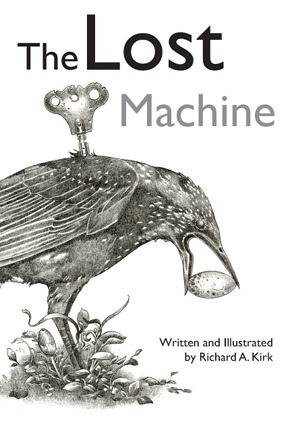
In a wasteland ravaged by plague, Lumsden Moss steps out of a decaying prison. Armed with a satchel of yellowed notebooks containing the fragile memories of five murdered children, he is determined to track down and confront their killer. Lumsden, accompanied by a stranger, begins a long journey to the vast City of Steps where he is forced to confront the horrors of the past and present.
Richard A. Kirk is best known as a rather mind-blowing artist whose commissioned work has accompanied the fiction of masters like Clive Barker and Caitlin R. Kiernan. His art demonstrates a knowledge of the Grotesque wedded to his own unique aesthetic. That aesthetic is texturally complex and uses precision of detail to create marvelously outlandish art. Kirk strikes me as the kind of creator whose devotion to discipline provides structure within which he can unleash a wild imagination. The composition of his images often evokes a misleading sense of stillness. Action has either just occurred or is about to occur. But these images aren't actually static—the movement is simply occuring at the micro-level as a form of acute seeing. As part of this intensity of vision, the environment around the subject matter is rendered in as complex a way—a living way—as the people or creatures foregrounded.
The fiction of Kirk, as exemplified by his first book The Lost Machine, shares many of these virtues, translated craft-wise for the demands of text.
The protagonist Lumsden Moss, a former school teacher, outlives a prison and sets out on a quest to track down the person he believes really committed the crimes. Along the way, he encounters an odd man named Irridis. Irridis has a halo of floating glass around his head—a deadly halo that functions as a weapon.
On their journey to the city where Moss believes he will pick up the trail, they bond despite Irridis' sometime merciless qualities. A scene in which they are attacked by feral boys is rendered in a clear-eyed, economic way that exemplifies Kirk's overall approach. When one boy fires at Irridis "Moss watched with horror as a plume of dust exploded up from Irridis's shoulder. Incredibly, the shot did not seem to faze him….The glass objects whirled in a circle around his covered head like a deadly crown…The boys raced off down the the trail, but Moss heard the ripping of sticks as Irridis' glass disks flew after them. Within seconds the disks returned and resumed their positions. Speechless, Moss could only stare down the empty, quiet trail."
A lesser writer, lacking the necessary discipline, would have shown Irridis's attack on the boys. Instead, Kirk evokes the "empty, quiet trail" to show they've been killed, and then cuts to these sentences: "Moss could not bring himself to look at the boy's face. Leaving Irridis in the clearing, he carried the child to the beach and buried him." The action itself is unimportant: what matters is how it came to occur and what happens after.
On a more macro level, the economy of the text impresses, in that Kirk isn't afraid to skip days here and there in the journey to get to the important points. There are few wasted words here, and as a result the text holds the reader's attention much more easily. This is especially important because at the novella length each exchange between Moss and Irridis must carry weight and establish character. In an odd way, there's a luminous quality to their journey created by what's been left out.
Similarly, Kirk brings his artist's eye to The Lost Machine. Details have clarity because he knows better than to clutter up the text with more than the one or two compelling images that matter, before moving on to the next scene. For example, in the prison Moss comes across a dead fellow inmate: "Mr. Box had arranged the songbirds' eggshells in a mandala pattern on the flor…Dead now, he sat in the passage with his back to his cell door, head bowed to his spread fingers where the latin names of innumerable songbirds were written in ballpoint pen. The eggshells crunched beneath Moss's boots. Even though Mr. Box was in no condition to lecture him, Moss felt shame redden his ears."
As their quest moves to the city of their destination, pleasing complications occur, as when Moss visits his sister, nicknamed Strange Buttons, to get "buttons" as offerings to three other sisters who may have information about the real murderer. What are the buttons? "They were indeed button-shaped but comprised of a spiral arrangement of seeds…In the center of each was a dehydrated spider with its legs folded inward. The spiders were stitched to the buttons with the same red thread she used for her labels." The purpose of these buttons is as interesting as the description, and just one of the ways in which Kirk brings freshness to weird fiction. These scenes evoke pleasant, non-derivative echoes of a Decadent literature updated to the modern era.
Another delight for the reader is Kirk's Gene Wolfe-ish approach to the milieu, which is possibly a post-collapse (or fantasy) Earth in which some people are called witches but there are also mechanical men. Folk cures side-by-side with science. In one great description Kirk writes, "At dawn, moss saw three women dropping loads of crumbling asbestos into the sea…On the strand the hulking remains of a great ship loomed in the fog, covered in the oxyacetylene scribbles of the shipbreaker's dissection." Such details might be thought to rest uneasily with talk of the supernatural and even with the rotting walls of the Kafkaesque prison Moss emerged from, but through some alchemy of the prose it all fits together to create a unique setting.
The unique resolution of Moss's quest carries emotional resonance in part because of the tension at the level of craft between Kirk's imagination and his restraint—the careful composition of Moss's character throughout The Lost Machine wedded to original imagery and situations. It's on the whole a masterful performance, even if there's a predictability to one particular plot element. The novella is highly recommended and I am looking forward to Kirk's future fiction with great anticipation. He's definitely bringing a fresh voice to weird fiction.
Also including five illustrations by Kirk and featuring an introduction by Mike Mignola.
A Hidden Gem: Richard A. Kirk's The Lost Machine originally appeared on Ecstatic Days on June 11, 2011.




The Kosher Guide to Imaginary Animals–Now Available in E-book Form
If you read the blog Shiksa in the Kitchen, you'll have seen their recent rave review of our The Kosher Guide to Imaginary Animals. The book is now available in e-book form from Amazon, Amazon UK, and Barnes & Noble. (Coming soon to Weightless Books, for those outside of the US/UK!)
It's a fun book, and I actually laughed out loud a few times while I was reading it. I think it would make a terrific host/hostess gift for a holiday party or dinner gathering. It might even make a fun bar or bat mitzvah gift– add it to the obligatory card and check to make things a little more personal. Perfect for people who love fantasy fiction.
You can also still get the book in the sumptuous little hardcover print version.
The Kosher Guide to Imaginary Animals–Now Available in E-book Form originally appeared on Ecstatic Days on June 11, 2011.








